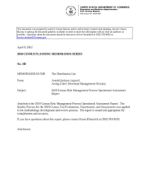
An official website of the United States government
Here’s how you know
Official websites use .gov
A .gov website belongs to an official government organization in the United States.
Secure .gov websites use HTTPS
A lock (
) or https:// means you’ve safely connected to the .gov website. Share sensitive information only on official, secure websites.
-
//
- Census.gov /
- Library /
- Publications /
- 2010 Census Risk Management Process Operational Assessments Report
2010 Census Risk Management Process Operational Assessments Report
2010 Census Risk Management Process Operational Assessments Report
Executive Summary
The purpose of the 2010 Census Risk Management Process Operational Assessments Report is twofold: (1) to assess how well the 2010 Census management staff and workforce implemented the formal risk management process and (2) to inform the 2020 Census program.
The formal program risk management process was not implemented at the beginning of the 2010 Census lifecycle. The formal identification and documentation of program risks and respective ratings began in 2007 by senior staff in the Decennial Management Division who then submitted the risks and ratings to an integrated group of managers for review, approval, and for cross- organizational oversight of risk management activities. Next, mitigation and contingency plans for program risks were formally documented, approved, and executed.
It was assumed that the Operational Integration Teams were implementing risk management from the beginning even though the risk management plan was not issued until June of 2008. In the spring of 2011, staff in the Decennial Management Division conducted three lessons learned sessions with users of the risk management process, and one-on-one interviews with the former DMD Division Chief and the former Assist ant Associate Director of Decennial Census and the American Community Survey. Users of the risk management process were asked what went well with the process and what did not work well. For those topics that did not work well, the facilitator asked these follow-up questions: (1) why did they not work well and (2) how could the process be improved.
The overwhelming majority of participants acknowledged that introducing a formal risk management process prompted staff to identify risks, mitigation activities, and put contingency plans in place if necessary. Further, having to report out regularly on risks, mitigation, and contingency activities forced staff to also review existing risks, identify new risks, and determine if mitigation activities were effective, and determine if contingency plans were necessary and adequate. Overall, participants reported implementing some degree of a formal risk management process was valuable.
Participants reported that the formal risk management process was instituted too late. Some teams and/or divisions already had their own process in place. They preferred not to modify their existing process to follow the formal process as this created additional work during dress rehearsal and production activities. At the program level, participants reported that it took too long to get formal mitigation and contingency plans in place, and thus delayed the regular review of how effective the mitigation plans were and preparedness should the risks become issues.
Participants offered suggestions for improving the 2020 Census risk management process. The areas for improvement fell into four categories: (1) Strategic Planning and Early Implementation, (2) Governance/More Clearly Defined Roles and Responsibilities (3) Improved Communication and Training, and (4) Focus on Integrating as Compared with Linking Program and Project Risks.
Others in Series
Publication
Publication
Publication
Share
Related Information
Some content on this site is available in several different electronic formats. Some of the files may require a plug-in or additional software to view.
 Yes
Yes
 No
NoComments or suggestions?


Top

